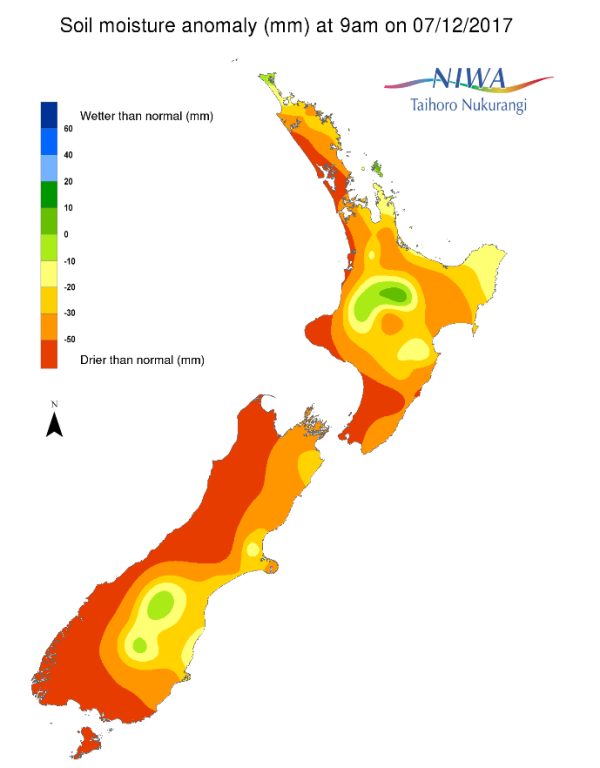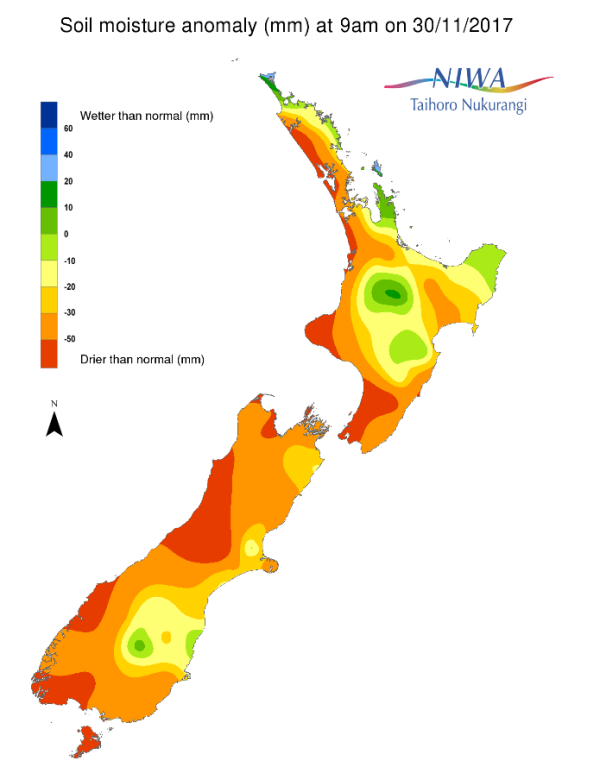A weekly update describing soil moisture across the country to help assess whether severely to extremely dry conditions are occurring or imminent. Regions experiencing these soil moisture deficits are deemed “hotspots”. Persistent hotspot regions have the potential to develop into drought.
Facts: Soil Moisture
Across the North Island, soil moisture levels have generally continued to decrease during the past week. The most significant decreases were observed from the Coromandel Peninsula to Bay of Plenty as well as Gisborne, northern Hawke’s Bay, northern Auckland and eastern Northland. Meanwhile, minor soil moisture increases occurred in small parts of central Waikato. The driest soils across the North Island compared to normal for this time of the year are found in Kaipara District, northern Auckland, much of Taranaki, and Manawatu District south to the Kapiti Coast and Wellington City, while the wettest soils for this time of the year are located in a small portion of central Waikato.
North Island hotspots are currently in place across Kaipara District, northern and central Auckland, southern Gisborne, much of Hawke’s Bay, Tararua District south to Wairarapa, and coastal Manawatu-Whanganui south to Kapiti Coast and Wellington City.
Across the South Island, soil moisture levels have continued to decrease for most locations during the past week. The most significant decreases were observed in the western half of the island across Tasman, West Coast, and Southland, while minor decreases occurred in the eastern South Island. A slight increase in soil moisture levels was observed in a small portion of Mackenzie and Waitaki districts. The driest soils across the South Island compared to normal for this time of the year are found in Tasman, West Coast, Southland, and Stewart Island, while the wettest soils for this time of the year are found in a small portion of Mackenzie and Waitaki districts.
South Island hotspots are currently located in Nelson, northern Tasman, coastal Marlborough, nearly all of northern and central Canterbury, coastal south Canterbury, Clutha District, and eastern and central Southland.
Outlook and Soil Moisture
Isolated pop-up showers will be possible across the central and upper North Island from Friday through to Sunday (8-10 December), with rainfall amounts expected to be 10 mm or less. However, some locations will likely see little or no rain during this time. On Monday, a band of heavier showers and even thunderstorms could impact the upper North Island, with isolated amounts of 10-20 mm possible. Generally dry weather is expected on Tuesday (12th December), with scattered showers possible on Wednesday and Thursday that may produce another few millimetres. Total rainfall in the next week across the North Island could range from as much as 25 mm in the Central Plateau to as little as 5 mm along the eastern coast.
Despite the expected rainfall during the next week, meaningful improvements in soil moisture levels are not expected. While minor improvements will be possible across the central and upper North Island, any hotspots there will remain in place. Meanwhile, low rainfall will lead to strengthening hotspots across the east coast and lower North Island.
In the South Island, a front will bring substantial rainfall to Fiordland and West Coast from Friday through the weekend (8-10 December), with amounts of 50-100 mm commonplace, along with isolated higher amounts. Unfortunately, little if any rainfall from this front will occur east of the Alps. Another front will move north across the central and lower South Island on Tuesday and Wednesday, bringing 5-15 mm to many locations from Southland to Canterbury. Isolated showers on Thursday (14th December) could produce a few more millimetres.
Due to substantial rainfall, soil moisture levels could improve significantly across Fiordland and West Coast during the next week. However, further soil moisture decreases could occur across the upper and eastern South Island. Therefore, hotspots in these areas are expected to remain in place, while increasing in coverage across southern Canterbury and Otago.


